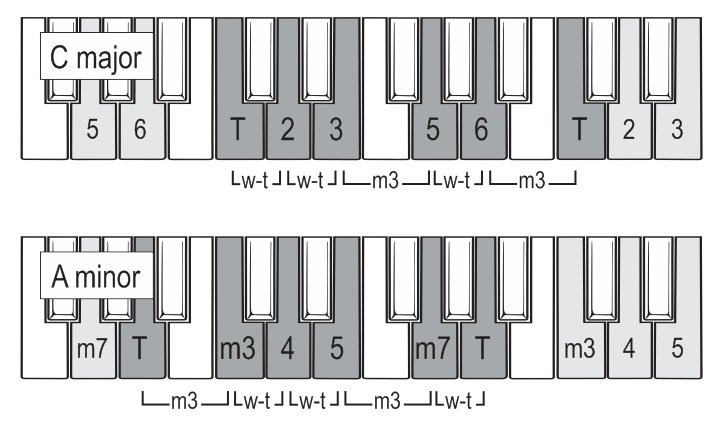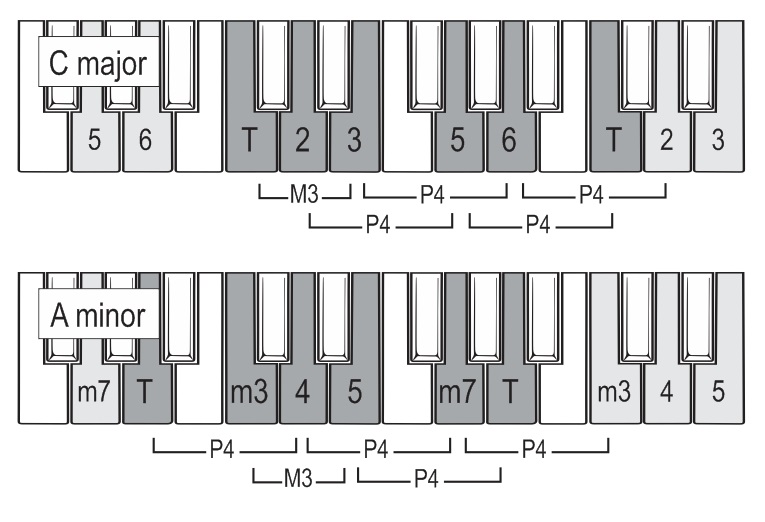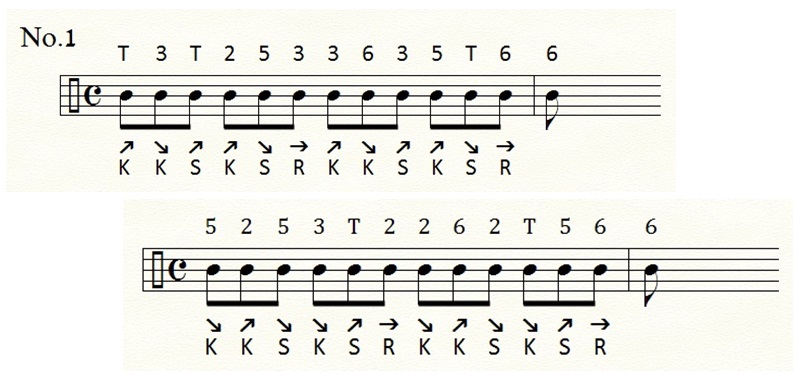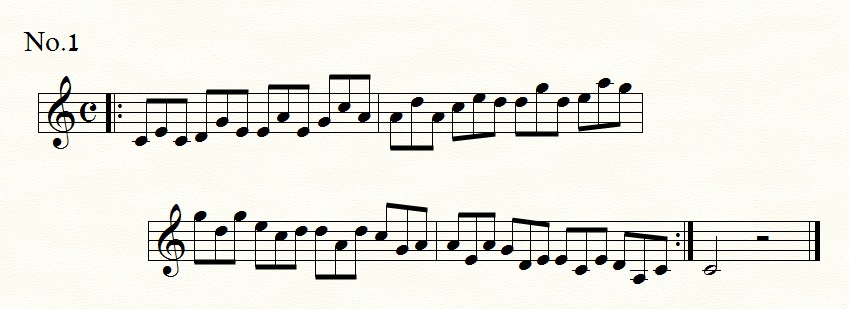Musicarta PATREON presents ...
Pentatonic Hanon 01-12-20
~ introduction/orientation ~
The Musicarta 'pentatonic Hanons' ('PentHans' for short) are Hanon-like keyboard dexterity and creativity exercises which use the pentatonic scales familiar from lots of popular music.
These exercises are much closer
to 'what you want to play' (and hear!) than the abstract finger exercises and scales of
traditional piano teaching. You'll find some basic pentatonic exercises in the Musicarta
Pentatonic Workbook and more advanced two-handed exercises on the Musicarta PentHan page.
The 'PentHan 01-12-20' series
PentHan 01-12-20 is a substantial exercise series which drills the major pentatonic scales in triplets with repeated notes - a great way to practise the keyboard dexterity required for improvising. (As you'll hear, these patterns are 'practically solos already'.)
Watch this introductory video for an overview of the series.
Working through some of the more basic Musicarta pentatonics material in the Musicarta Pentatonic Workbook before broaching this lesson series might be helpful. (There's some introductory material below.) Similarly,
some finger dexterity is an advantage - check out the Video Hanon here on Musicarta Patreon - or just pick it up on the fly!
First, a few basics. Skip ahead if you feel you're going over old ground - but DO come back and revise if you find yourself adrift.
The pentatonic scale
The Pentatonics Workbook 'Build-up of Tones' exercise is a tune (of sorts!) you learn and rehearse in order to memorise and reliably visualise the scale tones used in the major pentatonic scale.
Here is the exercise 'in C' - for learning the C major pentatonic scale. Copy!
This is one of a number of drills in the Musicarta Pentatonics Workbook, ensuring that you process enough learning material to successfully embed the pentatonic scales in your muscle memory, and turn your knowledge into skill.
It might seem very basic, but you need to know these notes and their pentatonic scale-tone names - T(onic), 2nd, 3rd, 5th, 6th - T-2-3-5-6.
You can use it any level you like. If it's 'child's play' - try visualising it in all keys on your morning run!
Step, skip, repeat
Pattern is incredibly useful for musical creativity - the PentHan 01-12-20 lesson series shows how to use pattern to improvise melodic lines.
Simple melodic-line patterns can be described in terms of steps - to a next-door scale tone, either up or down ('S'), skips - to a next-but-one scale tone, ditto ('K'), or repeats - repeating the same note ('R').
The PentHan 01-12-20 patterns are described in terms of pentatonic scale steps, skips and repeats, but because the pentatonic scale is 'gappy', they're not so immediately obvious.
Here's a briefing.
Pentatonic scale - Steps
In both the major and minor pentatonic scales, steps - moving to a next-door pentatonic scale tone ('S') - can be either whole tones (w-t) or minor thirds (m3):
 Steps (S) in the pentatonic scales
Steps (S) in the pentatonic scalesThere are three whole-tone (w-t) steps and two minor third (m3) steps in the pentatonic scales.
Here's a video about pentatonic steps and skips.
Pentatonic scale - Skips
Skips - moving to a next-but-one pentatonic scale tone ('K') can be either a major third (M3) or a perfect
fourth (P4).
 Skips (K) in the pentatonic scales
Skips (K) in the pentatonic scalesIn the pentatonic scales, there are four perfect fourth (P4) skips and one major third (M3) skip.
Play and listen to the steps and skips in the C pentatonic major scale.
The PentHan 01-12-20 patterns
The PentHan 01-12-20 patterns are described in terms of steps ('S' - next-door
pentatonic scale-tones), skips ('K' - next-but-one pentatonic
scale-tones) or repeated notes ('R').
The pattern repeats every six notes, and there's always one repeated note.
The Pattern No.1 "SKR" is:
K K S K S R | K K S K S R
In Pattern No.1, the repeated note (R) is the last note of the six to the first note of the next six.
Here's a sneak preview of the PentHan 01-12-20 Pattern No.1 video to watch while you browse the music and diagrams below. You don't have to 'read' the music; just check out the up/down contour and the size of the jumps.
(It's up-to-speed, but don't freak - training wheels version below!)
Try the pattern at your keyboard at any time! Use any fingers!
Here's the marked-up MS and a medium-paced audio to play while you listen out for/try that "SKR" pattern again.


NB: The 'K'/'S'/'R' under a note indicates where you go from there.... From C, skip up (K) to E. skip back to C, up a step (S) to D, skip up to G, step down to E, repeat (R) the E, (start again)...
There is full music, but the diagrams only show the first two ascending and descending patterns - because that's you want you to 'get'!
The overall PentHan 01-12-20 exercise shape
Each six-note pattern in the exercises rises by a pentatonic 'skip', so the six-note patterns start progressively on C/T - E/3 - A/6 - D/2 - G/5 - D/2 - A/6 - E/3 - C/T.

Look out for, play and memorise these notes. It's a great help to know at least the first note of a group with some certainty!
Can you hum the pattern from memory yet?
Transposing and playing by ear
Way along in the series - when you'll have a good basic grasp - we get even more abstract and present the pattern like this.


This shows PentHan 01-12-20 Pattern 1 'in any key', with the pentatonic scale tone given above (T-2-3-5-6) and SKR (step/skip/repeat) notation below.
MISSION PROMISE: You will, over time - by diligently completing the PentHan 01-12-20 series of lessons (!) - learn to improvise patterns using this kind of 'musical thinking'.
Listen to that medium-paced audio again while reading the pattern.
Do you start to see the pattern in the keyboard? Is the second half of the pattern 'coming to you' more easily?
Here's Pattern No.1 in D.
Now 'the pattern' really stands out, and the 'in any key' notation makes much more sense.
Slow audio build-up
In the playing-by-ear/transposing section, you get the option of an even
more step-by-step audio build-up. It's a good example to follow for
learning any exercise. Try using it to learn Pattern No.1 in C.



That's it - you're primed to go! Come back to this page for a refresher at any time. The series nav is page top right, or just click straight through to the first six exercises here.
Patreon
|
The MusicartaA methodical approach to keyboard syncopation for
|
PUBLICATIONS
exciting keyboard
creativity courses
CHORDS 101
WORKBOOK

~HANON~
video course

Musicarta
Patreon
PENTATONICS
WORKBOOK
video course

Creative Keyboard
video course

BEAT AND RHYTHM
WORKBOOK

- Volume 1 -

12-BAR PIANO
STYLES WORKBOOK

MUSICARTA MODES
WORKBOOK

PIANO STYLE

CANON PROJECT
video course

VARIATIONS
video course


- Piano Solo -
video course

- Piano Solo -


YouTube playlists





 THE LOGO
THE LOGO
